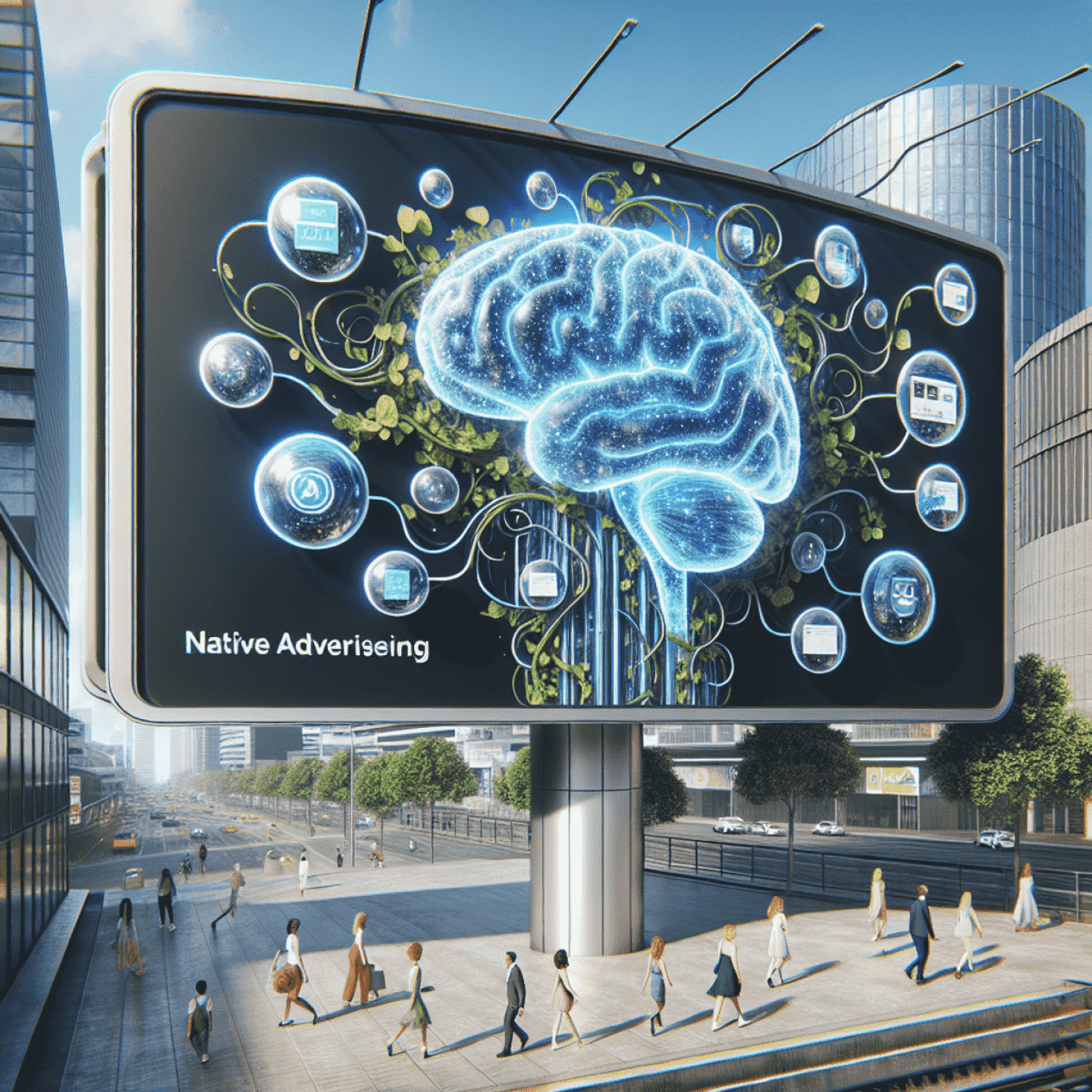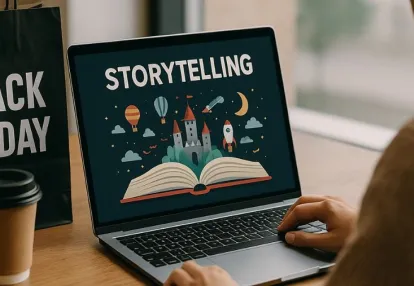
Our spy tools monitor millions of native ads from over 60+ countries and thousands of publishers.
Get StartedNative advertising has become an integral part of the digital marketing landscape. These are ads that blend seamlessly with the platform they're on, offering value to users rather than intruding on their experience. They have become a key strategy for advertisers aiming to reach audiences in a more organic and less disruptive manner.
The influence of Artificial Intelligence (AI) and machine learning is increasingly felt across industries, and advertising is no exception. AI-powered native ads offer unprecedented opportunities to refine targeting, personalize content, and optimize performance.
This article will delve into how AI is revolutionizing native advertising strategies, presenting both new opportunities and challenges. You'll discover how AI can transform content generation, enable precise audience segmentation, optimize ad performance, maintain authenticity, and shape the future landscape of native advertising.
We'll explore how AI can be used effectively in native advertising, including insights from Dale Lovell, CDO at Adyoulike. This will shed light on how AI helps create successful campaigns by leveraging context as a major metric for success. Ads that cater to the audience are proven to be more successful, and responsiveness is more of an expectation for today’s audiences.
You'll also learn about the ethical considerations involved in using AI in native advertising and the importance of balancing technology with a human touch.
As we dive into these topics, remember: AI is not a magic bullet but a powerful tool that can enhance your strategies when used effectively. Let's get started!
In the world of native advertising, artificial intelligence (AI) has completely changed how we create content. By using AI to automate content creation, we can now personalize native ads in ways that were never possible before. This not only makes our ads more effective but also helps us connect with our audience on a deeper level.
One of the biggest advantages of using AI in content generation is its ability to tailor ads to individual users. Instead of creating a one-size-fits-all ad, we can now analyze data about each user's preferences and behaviors to create personalized ads that are highly relevant to them. This level of personalization helps us grab their attention and increase engagement with our ads.
Another way AI enhances content generation is by making ads blend naturally with the surrounding content. Through the use of personalization algorithms and natural language generation (NLG) models, AI can create ad content that seamlessly integrates with the platform or website where it's displayed. This creates a better user experience as the ads don't feel intrusive or out of place.
Sentiment analysis is a powerful tool in AI's toolkit that helps us fine-tune native ads even further. By analyzing and understanding the emotions and preferences of users, we can ensure that our ads not only align with their interests but also resonate with their current emotional state. This level of understanding allows us to create more targeted and effective advertising campaigns.
By leveraging AI for content generation in native advertising campaigns, marketers can enjoy several key benefits:
As an advertiser, it's important to understand the impact of every interaction with your audience. Each touchpoint is an opportunity to leave a positive impression and build a meaningful connection with your consumers. This is where personalization plays a crucial role.
Through AI-driven tools like personalization algorithms and sentiment analysis, you can create native ads that not only grab attention but also resonate with your audience on a deeper level. By understanding their preferences, tailoring your messaging, and delivering content that speaks directly to them, you can increase the effectiveness of your native advertising strategy.
Audience segmentation is a crucial part of any successful native advertising campaign. It involves grouping people based on shared characteristics so that marketers can create content that truly speaks to their target audience. This, in turn, leads to higher levels of interest and interaction. Thanks to the power of artificial intelligence (AI), audience targeting has become much more effective and accurate.
One key aspect of AI that helps with audience segmentation is machine learning. This branch of AI is designed to analyze large sets of data and identify patterns or trends that might not be immediately obvious to humans. Given the overwhelming amount of information available, it's easy for us to miss important connections. Machine learning algorithms can process various types of data, such as how users behave online, what websites they visit, and basic demographic details, to create detailed profiles of different audience groups.
For example, machine learning can uncover which types of content are most appealing to specific segments of your audience. Armed with this knowledge, you can then customize your native ads to suit the preferences of each group. Naturally, this leads to better engagement and conversion rates.
Another benefit of using AI in advertising is its ability to predict future behavior based on past actions and interests. By analyzing someone's browsing history and online interactions, AI systems can anticipate their needs or desires even before they do. This gives businesses a competitive advantage by allowing them to reach potential customers at the right time with the right message.
While there are undeniable advantages to using AI for audience profiling, it's important for businesses to be mindful of certain ethical issues. Specifically, when it comes to collecting and utilizing personal data for targeting purposes:
To strike a balance between leveraging AI for audience segmentation and upholding ethical standards, marketers should:
By following these principles, businesses can harness the benefits of AI while still respecting the privacy and rights of their audience.
For those interested in gaining an advantage in native ad campaigns, Anstrex Native offers a comprehensive platform for analyzing competitors' ads. This allows you to refine your own strategy based on proven success stories, ultimately improving your chances of running profitable native advertising campaigns.
To make sure your native advertising campaigns are successful, it's important to use AI-powered tools to optimize ad performance. This approach allows you to constantly improve your campaigns, making them more effective and increasing your return on investment.
By using automated A/B testing, you can save time and money while also improving the chances of your campaign doing well. These tests use AI to analyze how users respond to different ads, giving you insights into which ones work best for your target audience.
Using machine learning to track conversions gives you a better understanding of why some ads do better than others. This knowledge helps you create native advertising strategies that are more likely to resonate with users.
AI-powered ad performance optimization is changing the way we test and improve native ads. By using tools like A/B testing and conversion tracking that are powered by AI, you can create personalized ads that connect with your audience and get valuable insights for future improvements.
Authentic advertising resonates more effectively with audiences, often leading to a deeper brand connection and loyalty. Yet, in an era where native advertising is becoming increasingly automated and data-driven with the use of AI, preserving that sense of authenticity—alongside adhering to brand safety standards—is a significant concern.
Here's how AI moderation is stepping into this delicate balance:
AI moderation tools serve as gatekeepers, ensuring content aligns with brand values and community standards while maintaining the authentic feel of native advertising.
AI moderation tools are not infallible. They require continuous training on new data sets and regular updates to their algorithms to account for evolving language use and cultural contexts. This ensures they remain effective in preserving authenticity and safeguarding brand integrity.
By integrating these advanced technologies into advertising workflows, brands leverage the power of AI to create safe, genuine connections with their audience without compromising on the personalized touch that makes native advertising so powerful.
With these foundational elements of authenticity and safety established through the application of AI moderation tools, there is potential for further innovation within the realm of native advertising.
As we look ahead, we can see some important trends shaping the world of native advertising. These changes are being driven by the continuous growth and development of AI technology.
One major shift is the increasing use of AI tools for coming up with new ideas and testing them out. As AI gets better, it's becoming really good at understanding how people speak and feel. This opens up new possibilities for using AI in creating content, making the process faster and more efficient without compromising on quality. For example, tools like OpenAI's GPT-3 allow advertisers to automatically generate ad copy while still being original and relevant.
Another trend that's emerging is the use of AI to target specific groups of people with ads. Machine learning algorithms are now able to handle huge amounts of data, find patterns in them, and discover things that humans might miss. This makes it possible for advertisers to reach their desired audiences with much greater accuracy and on a much larger scale than before.
However, relying too heavily on AI in native advertising also comes with its own set of problems.
Using machine learning models effectively requires having access to lots of user data. But this raises concerns about how that data is being collected and used. Advertisers need to be transparent about their practices and make sure they're following ethical guidelines when it comes to gathering data from users.
Another issue that can arise is when algorithms favor certain groups of people over others or unintentionally leave out certain segments of the audience. This can happen if the data used to train the algorithms is biased in some way. Advertisers should regularly check their AI systems for fairness and make changes if they find any biases.
To succeed in native advertising in the long run, it's crucial to approach AI in a responsible manner:
By doing these things, businesses can fully leverage the power of AI-driven native advertising while also minimizing potential risks. It's clear that the future of native advertising depends on using AI responsibly and innovatively.
AI has the power to completely change native advertising. However, it's important to remember that AI is just a tool, not a complete solution. While it can help marketers by analyzing data, boosting creativity, and delivering targeted content, it also requires time and careful analysis of results.
As you navigate the ever-changing world of AI-driven native advertising, it's crucial to prioritize ethics. Issues such as protecting user data, being transparent about algorithms, and using data responsibly should always be top of mind.
And don't forget, no matter how advanced AI gets, it can never replace human connection. Creating effective native ad experiences goes beyond algorithms – it requires understanding the context, emotions, and preferences of your audience. This combination of technology and human understanding will shape the future of AI in native advertising.
So go ahead and leverage the potential of AI in your native advertising strategies, but always stay true to your authentic self.
Receive top converting landing pages in your inbox every week from us.
Must Read
As third-party cookies fade away, contextual targeting is making a powerful comeback. Learn how to leverage native ads that align with user intent and content relevance to maintain high engagement and conversions. Discover modern tools and tactics that make cookie-free targeting both precise and scalable. Ideal for advertisers seeking privacy-friendly ways to drive performance in 2025 and beyond.
Liam O’Connor
7 minDec 9, 2025
Recently Updated
Native ads can make or break your holiday marketing success. Explore how to evaluate your recent campaigns and identify what worked—or what fell short—with native advertising. Learn key optimization tactics to boost engagement, strengthen audience trust, and increase conversions in future promotions. Ideal for marketers aiming to refine their ad strategies after the holiday rush.
Elena Morales
7 minDec 1, 2025
Quick Read
After Black Friday, shoppers crave more than just deals—they want connection and meaning. Explore how creative storytelling can turn post-sale campaigns into powerful conversion drivers. Learn how to craft narratives that build trust, strengthen brand loyalty, and inspire action beyond discounts. Perfect for marketers aiming to keep engagement high long after the sales frenzy ends.
Marcus Chen
7 minNov 29, 2025




